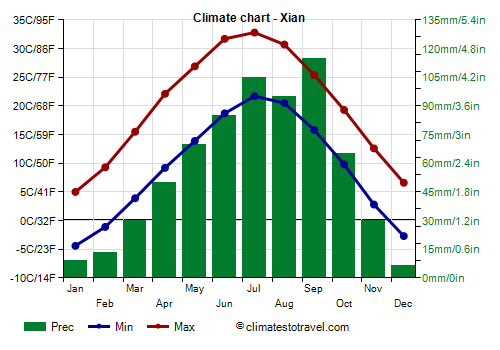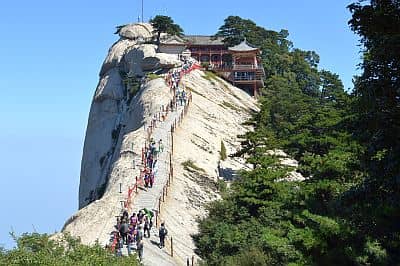Select units of measurement for the temperature and rainfall tables (metric or imperial).
Average weather, temperature, rainfall, sunshine hours

The climate of Xi'an is
continental, with cold, dry winters and hot, humid summers. The city is located in central China, at 400 meters (1,300 feet) above sea level, and at a latitude not very high, but it is almost a thousand kilometers (600 miles) away from the sea, and it is affected by the continentality of the Asian landmass, as well as by the summer monsoon. On the other hand, the position in a valley and the distance from the sea make the summer heat intense and uncomfortable, while in winter, cold air often stagnates on the ground.
Here are the average temperatures.
Xian - Average temperatures (1991-2020) |
| Month | Min | Max | Mean |
|---|
| January | -4.4 | 5 | 0.3 |
|---|
| February | -1.1 | 9.3 | 4.1 |
|---|
| March | 3.9 | 15.5 | 9.7 |
|---|
| April | 9.2 | 22.1 | 15.6 |
|---|
| May | 13.9 | 26.9 | 20.4 |
|---|
| June | 18.7 | 31.7 | 25.2 |
|---|
| July | 21.7 | 32.8 | 27.2 |
|---|
| August | 20.5 | 30.7 | 25.6 |
|---|
| September | 15.8 | 25.4 | 20.6 |
|---|
| October | 9.8 | 19.3 | 14.6 |
|---|
| November | 2.8 | 12.6 | 7.7 |
|---|
| December | -2.7 | 6.6 | 1.9 |
|---|
| Year | 9.1 | 19.9 | 14.45 |
|---|
The capital of the province of Shaanxi (Shensi), Xi'an is also one of the ancient Chinese capitals, and is home to numerous monuments, in addition to the famous Terracotta Army. Today it is a metropolis of millions of inhabitants, polluted as often happens in large Chinese cities.
Precipitation amounts to about 670 millimeters (26.3 inches) per year; owing to the monsoon, the rainiest season is summer, while the driest is winter. Here is the average precipitation.
Xian - Average precipitation| Month | Days |
|---|
| January | 9 | 4 |
|---|
| February | 13 | 5 |
|---|
| March | 30 | 7 |
|---|
| April | 50 | 8 |
|---|
| May | 70 | 10 |
|---|
| June | 85 | 9 |
|---|
| July | 105 | 11 |
|---|
| August | 95 | 10 |
|---|
| September | 115 | 12 |
|---|
| October | 65 | 11 |
|---|
| November | 30 | 6 |
|---|
| December | 6 | 4 |
|---|
| Year | 670 | 97 |
|---|
, from December to February, is cold and dry: the average January temperature is 0.5 degrees Celsius (32.5 °F). Precipitation is rare and not abundant, but the sky is often cloudy. However, given the low temperatures, there may be some snowfalls, generally light. The wind from the north can bring cold snaps, with minimum temperatures around -15 °C (5 °F), as well as the dust of the Gobi Desert. On the other hand, the south wind, which descends from the mountains (Qin mountains), can bring mild days, with highs around 15/20 °C (59/68 °F).
In
spring, from March to May, the temperature increases, while rainy days become gradually more frequent. The amount of sunshine is just acceptable. In March and April, the clash between air masses can cause sand storms. In May it can already be very hot, in fact the temperature can reach or even exceed 35 °C (95 °F).
Summer, from June to August, is hot and muggy; due the Asian monsoon, it is the rainiest season. June is already a hot month, but rainfall and muggy heat generally arrive in July, or during the month of June. However, the rains display an erratic pattern from year to year.
The amount of sunshine is fairly good, in fact, summer is the sunniest season, although there are cloudy days even in this season. The rains occur mainly in the form of downpours or thunderstorms. During some years, the rains can be abundant, causing landslides and flash floods, in the watercourses that descend from the mountains, also in September, and in some cases, but more rarely, even in October.
The periods of good weather during the summer can be very hot, with highs around 38/40 °C (100/104 °F), and in these cases, it remains uncomfortably hot even at night. In June 2005, the temperature reached 41.7 °C (107.1 °F). Usually, August is not as hot as June and July, but it is more sultry.
Autumn, from September to November, is initially mild, and gradually becomes cooler, and then quite cold by November, but sometimes it can get cold at night already in October. Rainfall is initially quite frequent: September is even the wettest month of the year. As the weeks pass, rainfall gradually decreases, while the sky remains often cloudy.

As mentioned, the amount of
sunshine in Xi'an is not very good, although some sunny days can occur throughout the year. Here are the average sunshine hours per day.
Xian - Sunshine hours| Month | Average | Total |
|---|
| January | 4 | 120 |
|---|
| February | 4.5 | 120 |
|---|
| March | 5 | 160 |
|---|
| April | 6 | 185 |
|---|
| May | 6.5 | 200 |
|---|
| June | 6.5 | 200 |
|---|
| July | 7 | 210 |
|---|
| August | 5.5 | 175 |
|---|
| September | 4.5 | 135 |
|---|
| October | 4 | 120 |
|---|
| November | 4 | 120 |
|---|
| December | 4 | 120 |
|---|
| Year | 5.1 | 1870 |
|---|
About 100 km (60 miles) east of Xi'an, and near the city of Huayin, we find
Mount Hua (
Hua Shan), 2,154 meters (7,070 feet) high, one of the five Chinese sacred mountains. On slopes and peaks, temples are found. The path that leads to the top is particularly steep and therefore dangerous. Here, winter is freezing but dry (though sometimes it can snow), while summer, the season when there are most tourists, is cool, but even more rainy than the lowlands. Here are the average temperatures.
Hua Shan - Average temperatures (1991-2020) |
| Month | Min | Max | Mean |
|---|
| January | -8.4 | -1.7 | -5 |
|---|
| February | -5.9 | 0.8 | -2.6 |
|---|
| March | -1.3 | 5.7 | 2.2 |
|---|
| April | 4.5 | 11.8 | 8.2 |
|---|
| May | 8.9 | 15.8 | 12.4 |
|---|
| June | 13.3 | 19.7 | 16.5 |
|---|
| July | 15.5 | 21.5 | 18.5 |
|---|
| August | 14.4 | 20.1 | 17.2 |
|---|
| September | 10.1 | 15.7 | 12.9 |
|---|
| October | 4.7 | 10.6 | 7.6 |
|---|
| November | -0.9 | 5.6 | 2.3 |
|---|
| December | -6.6 | 0.2 | -3.2 |
|---|
| Year | 4.1 | 10.5 | 7.3 |
|---|

Best Time
The
best times to visit Xi'an are spring and autumn, in particular the months of April and October. In these months it can sometimes get cold at night, with lows around freezing, while in May and September, it can be hot during the day. Also, September is a quite rainy month, with the risk of flooding every so often. Usually, it rains less in spring than in autumn.